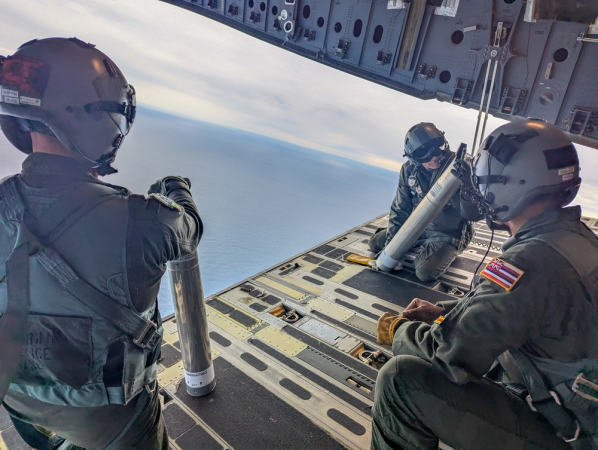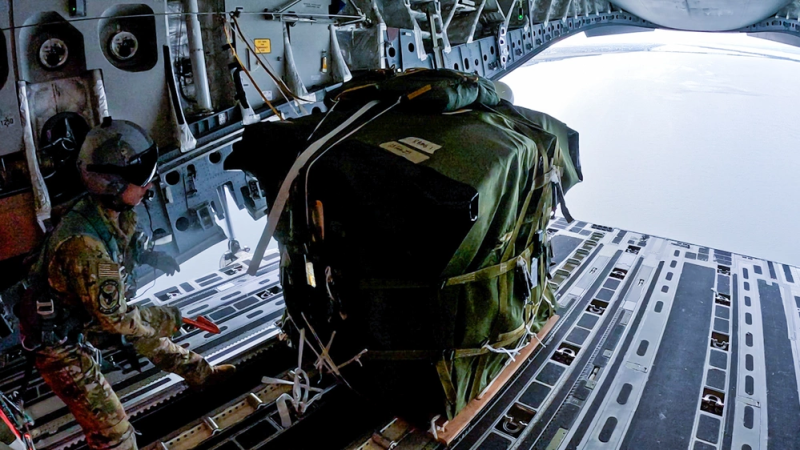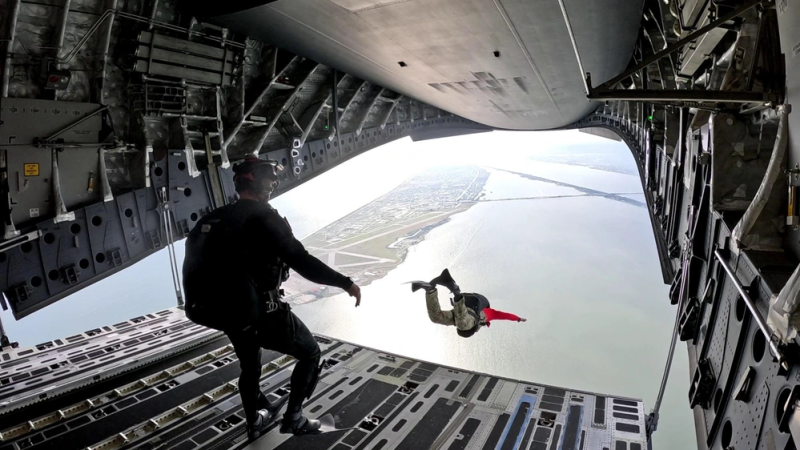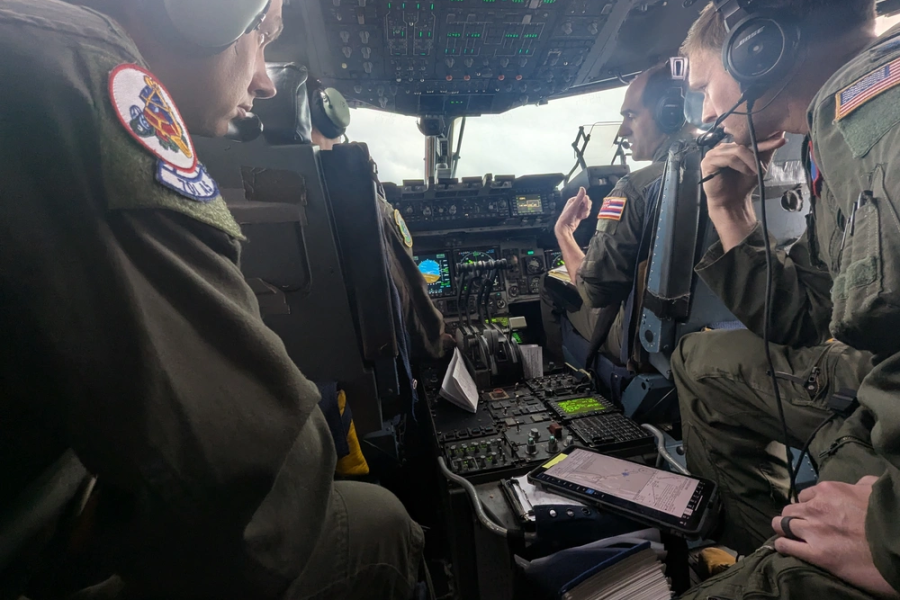As the number of crewed spaceflights ticks up, the Air Force expects to train more of its C-17 transport crews to help pluck astronauts out of the water as part of its Human Space Flight Support mission
Last month, five pilots and three loadmasters from the 315th Airlift Wing, an Air Force Reserve C-17 unit based at Joint Base Charleston, S.C., traveled to Patrick Space Force Base, Fla., to learn HSFS search and rescue airdrop techniques, which are used to pick up astronauts after their spacecraft splashes down in the water.
From Jan. 14-17, the 315th Airmen performed 10 airdrops and 30 pararescue jumps in rough seas and winter temperatures with Hawaii Air National Guardsmen from the 204th Airlift Squadron and Patrick-based Reservists from the 308th Rescue Squadron.
The wing’s chief of weapons and tactics and HSFS lead planner, Maj. Ryan Schieber, told Air & Space Forces Magazine that, to his knowledge, this was the first Reservist C-17 crew to train in rescue airdrop and the HSFS mission.
The training comes amid a growing number of spaceflights run by private companies such as SpaceX and Boeing, and as NASA prepares for Artemis II, its first crewed moon mission since 1972, set to launch in 2026. The uptick has HSFS-trained units such as the 204th Airlift Squadron standing alert for astronaut retrievals three to four times a year, according to a Jan. 17 press release.
“With an increase in crewed space flight, naturally the number of alerts for HSFS will increase,” Schieber said.

The HSFS mission stretches back to 1959, when Department of Defense Mercury Support was established for Project Mercury, America’s first human spaceflight program. The office changed names several times over the decades as it supported the Gemini, Apollo, Skylab, Space Shuttle, and other programs, before becoming Detachment 3 (Det. 3), First Air Force in 2021.
Today, Det. 3 is the air component of U.S. Space Command—Air Forces Space—and manages global contingency rescue forces during launches and landings for NASA’s Commercial Crew Program (i.e. SpaceX and Boeing) and the upcoming Artemis missions, a First Air Force spokesperson explained.
Defense Department forces “are on alert for launch, freeflight, and landing,” the spokesperson said. “The HSFS mission includes the search and rescue of astronauts, the recovery of crewed space flight assets, the pre-positioning of rescue forces, and providing unique communication abilities.”
For example, when the uncrewed Orion capsule splashed down west of Baja California in 2022 after orbiting the moon as part of the Artemis I mission, Det. 3 oversaw the capsule recovery. The outfit trained a team of Navy divers to install special hardware on the spacecraft to help with recovery, and to breach the capsule to rescue astronauts if future missions require it, a press release explained at the time.
Det. 3 also brought the crew of the amphibious transport dock ship USS Portland up to speed on recovering spacecraft, taught Navy helicopter crews how to spot and recover any separated spacecraft parts, and accompanied the ship to pick up Orion.
“The combined NASA, Navy, and Det. 3 team has been preparing for this event since the beginning of the Orion program, which dates back to 2011,” Lt. Col. Dave Mahan, then-Det. 3’s Artemis program director, said at the time. Mahan now commands the detachment. “It was amazing to watch all of that planning and just-in-time training in action during splashdown and recovery.”

For past missions involving its spacecraft, SpaceX used its own ships for recovering Crew Dragons and the crews aboard. That will likely happen March 12, when astronauts Butch Wilmore and Suni Williams are expected to splash down aboard a Crew Dragon after spending an unexpected nine months aboard the International Space Station since the Boeing Starliner they rode into orbit malfunctioned on approach to the ISS last June. Also splashing down with them will be cosmonaut Aleksandr Gorbunov and astronaut Col. Nick Hague, the first Space Force Guardian to launch into space.
If anything goes wrong, Air Force crews are trained to help. HSFS missions use the C-17 for its airdrop capability and its longer range compared to smaller aircraft such as the HC-130J, the First Air Force spokesperson said.
The biggest differences between rescue airdrops and conventional airdrops, Schieber explained, is that HSFS rescue airdrops typically take place over water and involve Guardian Angels, the combat rescue officers, pararesuemen, and other Airmen who conduct or support personnel recovery.
“Our crews received training on search and rescue patterns that would assist in identifying the recovered capsule’s location for the follow-on recovery,” he said. “Additionally, the mission set requires our loadmasters to utilize flares and smoke to assist in visually identifying the recovered capsule.”

It also involves dropping gear such as jet-skis and rigid inflatable boats, Master Sgt. Makaio Roberts, HSFS deputy program manager with the 204th Airlift Squadron, said in a Jan. 17 video about the training.
With more experience on C-17 HSFS missions, it was Roberts’ and his fellow Hawaiians’ task to certify the Charleston Airmen for the astronaut recovery mission.
“This is a very unique operation for the C-17 to participate in rescue airdrops,” Schieber said in the video. “It’s something that most of the C-17 crews haven’t experienced before.”
Other crews from the Active-duty, Reserve, and Air National Guard will likely follow in their footsteps, the First Air Force spokesperson said.
“We expect more C-17 crews from the total force to become trained on the HSFS airdrop training as our nation’s space programs expand.”
